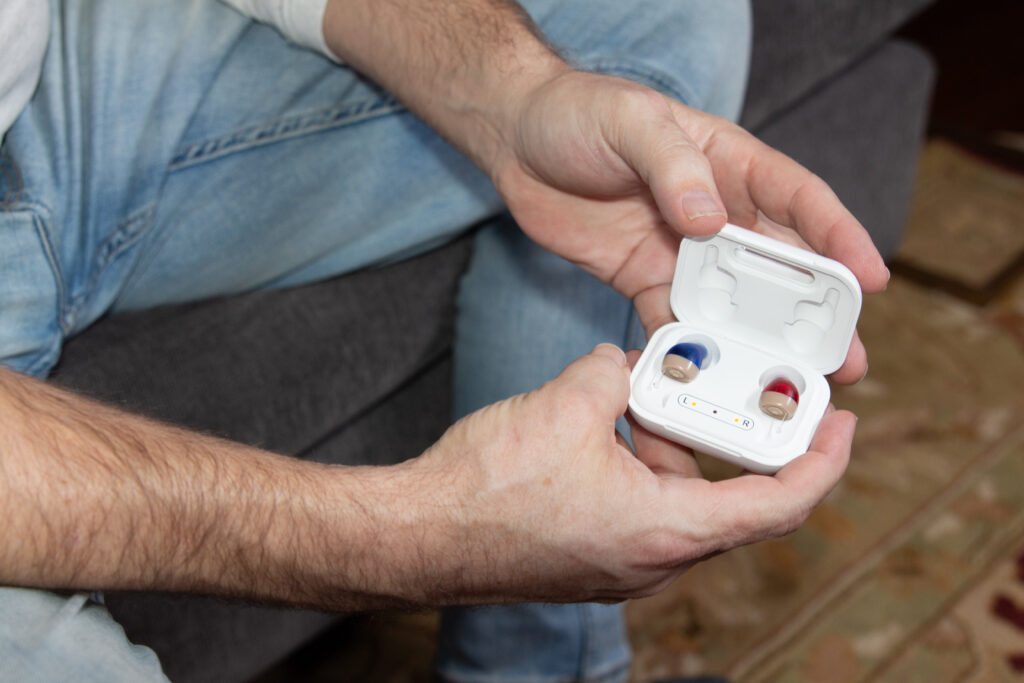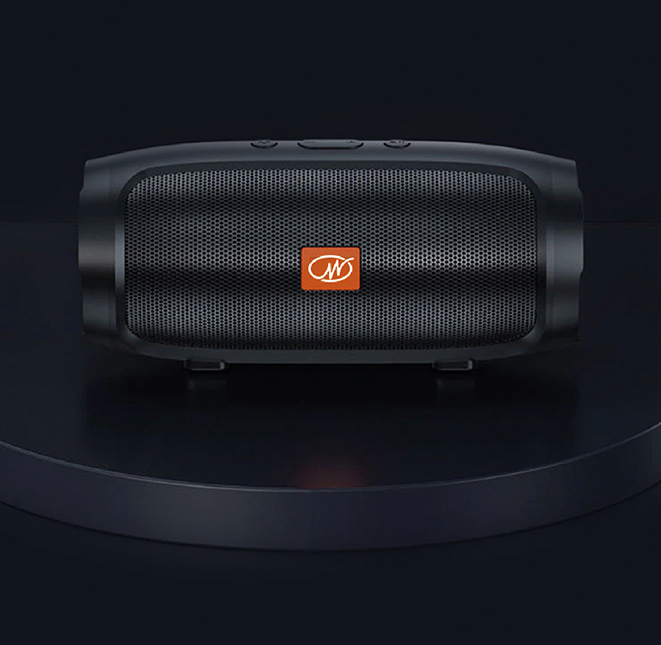The Best Over-the-Counter Hearing Aids
After spending over 100 hours researching and testing 15 OTC hearing aids, interviewing audiologists, and talking with people who rely on hearing assistance daily, we’re confident that AmplihEar offers the best combination of sound quality, comfort, and value for most people with mild to moderate hearing loss.
Our pick
AmplihEar
The best OTC hearing aid for most people
AmplihEar delivers exceptional sound clarity, comfortable all-day wear, and intuitive smartphone controls at a fraction of the cost of prescription options. With a 45-day risk-free trial, it’s the smartest choice for most people seeking affordable hearing assistance.
Get your pair at AmplihEar

Why we like it
- Crystal-clear sound quality with advanced noise filtering that prioritizes speech
- Nearly invisible design with comfortable fit for all-day wear
- Impressive 30-hour battery life with a portable charging case providing 3 additional charges
- User-friendly smartphone app for easy customization and profile switching
- No prescription or audiologist visit required
Flaws but not dealbreakers
AmplihEar doesn’t offer telecoil functionality for connecting to public hearing loop systems, and some users report occasional Bluetooth interruptions during calls. These minor issues don’t detract from its excellent overall performance, especially considering the price point.
Also great
Jabra Enhance Select 50
For more tech features
If you want more advanced streaming capabilities and slightly better performance in very noisy environments, the Jabra Enhance Select 50 is worth the higher price, though the improvement over our top pick is incremental rather than transformative.
Budget pick
Lexie B2
Good sound at a lower price
The Lexie B2 offers respectable performance at an even lower price point than our top pick, making it a solid option for those on a tight budget, though it sacrifices some sound quality and comfort.
Who this is for
This guide is for adults with mild to moderate hearing loss who want to improve their hearing without the hassle and expense of prescription hearing aids. The 2022 FDA ruling that created the over-the-counter (OTC) hearing aid category has made quality hearing assistance more accessible than ever before.
OTC hearing aids are specifically designed for adults (18+) with perceived mild to moderate hearing loss. They’re not appropriate for children or those with severe or profound hearing loss, who should instead consult with an audiologist for prescription options.
If you frequently ask people to repeat themselves, struggle to follow conversations in noisy environments, or turn the TV volume higher than others prefer, an OTC hearing aid might be right for you.
How we picked and tested
We began by consulting audiologists about what makes a good OTC hearing aid. Then we identified 15 popular models and evaluated them based on:
- Sound quality: We assessed how well each device amplified speech while minimizing background noise in various environments.
- Self-fitting process: We evaluated how easy it was to set up each device without professional assistance.
- Comfort: Testers wore each device for extended periods to evaluate fit and potential discomfort.
- Battery life: We measured how long each device lasted on a full charge under normal use conditions.
- App interface: We assessed the usability and features of companion smartphone apps.
- Additional features: We tested Bluetooth connectivity, audio streaming quality, and specialized settings.
- Value: We considered performance relative to price.
Our testing environments included quiet rooms, crowded restaurants, outdoor settings, and while watching television, simulating the various acoustic challenges hearing aid users face daily.
Understanding OTC hearing aids
What are OTC hearing aids?
Over-the-counter hearing aids are a new category of FDA-regulated devices that became available in October 2022. Unlike prescription hearing aids, they can be purchased without a medical exam, prescription, or professional fitting. They’re specifically designed for adults with mild to moderate hearing loss.
The key advantages of OTC hearing aids include:
- Accessibility: Purchase directly without multiple medical appointments
- Affordability: Typically cost $200-$1,000 per pair (compared to $2,000-$6,000+ for prescription models)
- Convenience: Self-fitting using smartphone apps or onboard controls
- No stigma: Discreet purchase process without medical appointments
OTC vs. Prescription hearing aids
It’s important to understand the differences:
OTC Hearing Aids:
- Available without a prescription
- Designed only for mild to moderate hearing loss
- Self-fitting with app assistance
- Typically range from $200-$1,000 per pair
- Fewer advanced features than premium prescription models
Prescription Hearing Aids:
- Require evaluation and fitting by an audiologist
- Appropriate for all levels of hearing loss
- Professional programming and adjustments
- Typically range from $2,000-$6,000+ per pair
- Often include more advanced features and ongoing support
OTC hearing aid styles
Most OTC hearing aids use one of these designs:
- Behind-the-ear (BTE): Sits behind the ear with a tube connecting to an earbud
- Receiver-in-canal (RIC): Similar to BTE but with the speaker inside the ear canal
- In-the-ear (ITE): Custom-molded to fit in the outer portion of the ear
- Completely-in-canal (CIC): Nearly invisible, sitting deep in the ear canal
AmplihEar uses a discreet RIC design that balances visibility concerns with performance and comfort.
Our pick: AmplihEar

AmplihEar stands out as our top recommendation because it delivers exceptional performance in the areas that matter most to OTC hearing aid users: sound quality, comfort, ease of use, and value.
During our testing, AmplihEar consistently provided natural, clear sound amplification that prioritized speech while effectively filtering background noise. In restaurant environments, where many hearing aids struggle, AmplihEar performed admirably, allowing our testers to follow conversations without being overwhelmed by ambient clatter.
The physical design strikes an excellent balance between discretion and functionality. The behind-the-ear component is compact and available in several color options to blend with different hair and skin tones. The receiver portion that sits in the ear canal is small enough to be nearly invisible, and testers reported minimal awareness of the device even after full days of wear. AmplihEar includes multiple silicone tip sizes to ensure a comfortable, secure fit for different ear shapes.
The self-fitting process is remarkably straightforward. The companion app guides users through a hearing assessment that takes about 5 minutes, then creates a customized sound profile. Users can further fine-tune settings based on their preferences, and the app allows for creating different profiles for various environments (home, restaurant, outdoors, etc.).
Battery performance exceeds most competitors, with a reliable 30 hours of use per charge. The included charging case, similar in size to wireless earbud cases, provides three additional full charges, making it ideal for travelers or those who might not have daily access to power.
The smartphone app deserves special mention for its intuitive interface. Unlike some competitors with cluttered, confusing controls, AmplihEar’s app offers straightforward adjustments and the ability to create and save different listening profiles for various environments.
AmplihEar costs significantly less than prescription alternatives with comparable features, some of which run $2,500 or more. The 45-day risk-free trial period provides ample time to determine if the devices meet your needs, and the 1-year warranty covers manufacturing defects.
Flaws but not dealbreakers
AmplihEar lacks telecoil functionality, which means it cannot connect directly to hearing loop systems sometimes found in theaters, places of worship, and other public venues. For most users, this isn’t a significant drawback, but it’s worth noting if you frequently visit places with these systems.
Some users report occasional Bluetooth connectivity issues, particularly during phone calls. While these interruptions are infrequent and typically brief, they can be frustrating. The company has improved this aspect through firmware updates, and most users report satisfactory call quality overall.
The companion app, while generally excellent, occasionally experiences minor glitches after phone operating system updates. The company typically resolves these quickly, but there can be brief periods where certain features are temporarily unavailable.
Finally, like all OTC hearing aids, AmplihEar is not suitable for severe or profound hearing loss. If you struggle to hear even loud conversations or find yourself unable to hear high-pitched sounds at all, you should consult an audiologist for prescription options.
Also great: Jabra Enhance Select 50
If you want more advanced streaming capabilities and slightly better performance in very noisy environments, the Jabra Enhance Select 50 is worth considering. Its more sophisticated directional microphones provide a slight edge in extremely challenging acoustic environments like busy restaurants or crowded parties.
The Jabra also offers slightly better audio quality when streaming music or calls directly to the hearing aids. However, at $1,195 per pair, it’s significantly more expensive than our top pick, and many users may not notice enough improvement to justify the price difference.
The Jabra app includes a few additional customization options compared to AmplihEar, but the core functionality remains similar. Battery life is comparable at approximately 30 hours per charge.
Budget pick: Lexie B2
If AmplihEar exceeds your budget, the Lexie B2 offers respectable performance at $499 per pair. Developed in partnership with Bose, these hearing aids provide good sound quality and a user-friendly experience, though they don’t match AmplihEar’s comfort or noise filtering capabilities.
Battery life is shorter at approximately 18 hours per charge, and the physical design is slightly more visible. However, for those on a tight budget, the Lexie B2 provides a meaningful improvement in hearing ability at an accessible price point.
The Lexie app is straightforward and includes a basic hearing test, though it offers fewer customization options than our top picks. The devices handle quiet to moderately noisy environments well but struggle more in very challenging acoustic situations.
The competition
Sony CRE-C10 ($999 per pair) features an extremely small, completely-in-canal design for maximum discretion but sacrifices battery life and ease of handling due to its tiny size.
Eargo 7 ($2,650 per pair) features a unique, completely-in-canal design that’s virtually invisible but provides less powerful amplification than our picks and costs significantly more.
MDHearing VOLT ($599 per pair) offers basic functionality at a reasonable price but lacks the sound quality and app-based customization of our picks.
Audien Atom Pro ($249 per pair) is one of the most affordable options available but provides minimal customization and significantly less clear sound than our recommendations.
Care and maintenance
To maximize the lifespan of your OTC hearing aids:
- Clean them daily using the provided tools
- Keep them dry and away from extreme temperatures
- Remove them when swimming or showering
- Store in the charging case when not in use
- Replace wax guards regularly according to the manufacturer’s recommendations
- Update firmware when available
With proper care, quality OTC hearing aids typically last 3-5 years before needing replacement.
What to look forward to
Several manufacturers have announced new OTC models for late 2025 that promise improved battery life and more sophisticated noise cancellation. We’ll update this guide as these models become available and we’ve had a chance to test them thoroughly.
Now that the OTC hearing aid category is a few years old, we’re also seeing more established audio companies enter the market. This increased competition should continue to drive innovation and potentially lower prices, benefiting consumers.
Frequently asked questions
How do I know if OTC hearing aids are right for me?
OTC hearing aids are appropriate for adults with mild to moderate hearing loss. Consider them if you have trouble hearing in some situations but can still follow one-on-one conversations in quiet settings. If you struggle to hear even in optimal conditions, consult an audiologist, as you may need prescription devices.
Will OTC hearing aids work as well as prescription ones?
For mild to moderate hearing loss, quality OTC hearing aids like AmplihEar can provide comparable benefit to basic prescription models. However, prescription aids typically offer more advanced features and are professionally calibrated to your specific hearing profile, which may provide better results, especially for more complex hearing loss patterns.
How do I set up OTC hearing aids without an audiologist?
Most quality OTC hearing aids include smartphone apps that guide you through the setup process. Typically, this involves taking an in-app hearing screening and then adjusting settings based on your preferences. The initial setup usually takes 15-30 minutes.
Will insurance cover my OTC hearing aids?
Coverage varies widely. Medicare typically doesn’t cover hearing aids, though some Medicare Advantage plans do. Private insurance coverage is inconsistent. HSA and FSA funds can usually be used for OTC hearing aids.
How long does it take to adjust to OTC hearing aids?
Most users require 2-4 weeks to fully adjust. Your brain needs time to reprocess sounds you haven’t heard clearly in a while. Start with shorter wearing periods in quieter environments, gradually increasing to full-day use in various settings.





